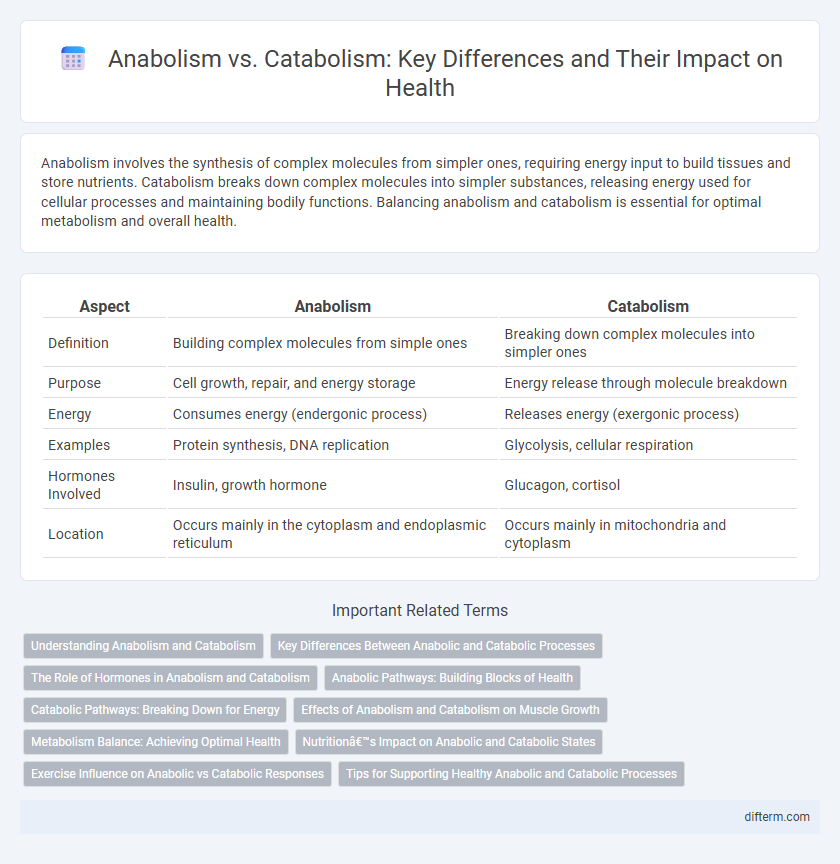Anabolism involves the synthesis of complex molecules from simpler ones, requiring energy input to build tissues and store nutrients. Catabolism breaks down complex molecules into simpler substances, releasing energy used for cellular processes and maintaining bodily functions. Balancing anabolism and catabolism is essential for optimal metabolism and overall health.
Table of Comparison
| Aspect | Anabolism | Catabolism |
|---|---|---|
| Definition | Building complex molecules from simple ones | Breaking down complex molecules into simpler ones |
| Purpose | Cell growth, repair, and energy storage | Energy release through molecule breakdown |
| Energy | Consumes energy (endergonic process) | Releases energy (exergonic process) |
| Examples | Protein synthesis, DNA replication | Glycolysis, cellular respiration |
| Hormones Involved | Insulin, growth hormone | Glucagon, cortisol |
| Location | Occurs mainly in the cytoplasm and endoplasmic reticulum | Occurs mainly in mitochondria and cytoplasm |
Understanding Anabolism and Catabolism
Anabolism involves the synthesis of complex molecules from simpler ones, requiring energy input to build proteins, nucleic acids, and lipids crucial for cell growth and repair. Catabolism breaks down these molecules into smaller units, releasing energy used to fuel metabolic activities and maintain cellular functions. Understanding the balance between anabolism and catabolism is key to optimizing metabolism, muscle development, and overall health maintenance.
Key Differences Between Anabolic and Catabolic Processes
Anabolic processes involve the synthesis of complex molecules from simpler ones, requiring energy input, essential for tissue growth and repair, such as protein synthesis from amino acids. Catabolic processes break down complex molecules into simpler ones, releasing energy stored in chemical bonds, crucial for providing energy during cellular activities. The key difference lies in anabolic pathways being constructive and energy-consuming, while catabolic pathways are degradative and energy-releasing.
The Role of Hormones in Anabolism and Catabolism
Hormones such as insulin, growth hormone, and testosterone play crucial roles in anabolism by promoting protein synthesis and tissue growth, while cortisol and adrenaline drive catabolism by stimulating the breakdown of glycogen, fats, and proteins for energy. The balance between anabolic and catabolic hormones regulates metabolic homeostasis, influencing muscle mass, fat storage, and overall energy availability. Understanding hormonal impact on these processes is essential for optimizing health, athletic performance, and recovery.
Anabolic Pathways: Building Blocks of Health
Anabolic pathways drive the synthesis of essential macromolecules such as proteins, lipids, and nucleic acids, crucial for cellular repair and growth. These metabolic routes utilize ATP and reducing agents like NADPH to convert simple precursors into complex biomolecules, supporting muscle development and tissue regeneration. Efficient anabolic activity underpins overall health by maintaining homeostasis, promoting recovery, and enhancing metabolic balance.
Catabolic Pathways: Breaking Down for Energy
Catabolic pathways involve the breakdown of complex molecules like carbohydrates, fats, and proteins into simpler compounds, releasing energy stored in chemical bonds. These pathways include glycolysis, the citric acid cycle, and oxidative phosphorylation, which collectively produce ATP, the primary energy currency of cells. Efficient catabolism is essential for maintaining metabolic balance and supporting cellular functions, especially during physical activity and fasting.
Effects of Anabolism and Catabolism on Muscle Growth
Anabolism promotes muscle growth by synthesizing proteins and repairing muscle fibers, leading to increased muscle mass and strength. Catabolism breaks down muscle tissue to release energy, which may result in muscle loss if not balanced with sufficient nutrition and recovery. Maintaining a balance between anabolic and catabolic processes is crucial for optimal muscle development and overall health.
Metabolism Balance: Achieving Optimal Health
Anabolism and catabolism are critical components of metabolism that maintain the body's energy balance; anabolism builds complex molecules from simpler ones, supporting tissue growth and repair, while catabolism breaks down molecules to release energy. A proper metabolism balance enhances cellular function, promotes weight management, and supports overall health by optimizing energy utilization and nutrient assimilation. Disruptions in this balance can lead to metabolic disorders, highlighting the importance of nutrition and exercise in maintaining metabolic homeostasis.
Nutrition’s Impact on Anabolic and Catabolic States
Nutrition plays a crucial role in regulating anabolic and catabolic states by providing the necessary macronutrients and micronutrients to support muscle growth and repair during anabolism, while preventing excessive protein breakdown associated with catabolism. Adequate protein intake, combined with carbohydrates and healthy fats, enhances the release of anabolic hormones such as insulin and growth hormone, promoting tissue synthesis and energy storage. Conversely, inadequate nutrient consumption or prolonged fasting triggers catabolic pathways, increasing cortisol levels and muscle protein degradation to meet energy demands.
Exercise Influence on Anabolic vs Catabolic Responses
Exercise stimulates anabolic responses by promoting muscle protein synthesis through resistance training, which enhances muscle growth and repair. In contrast, prolonged or intense endurance exercise triggers catabolic pathways, increasing protein breakdown to supply energy and maintain metabolic balance. Balancing exercise intensity and nutrition is crucial to optimize anabolic benefits while minimizing excessive catabolic effects for overall health and muscle maintenance.
Tips for Supporting Healthy Anabolic and Catabolic Processes
Maintaining a balanced diet rich in protein supports anabolic processes by promoting muscle growth and tissue repair, while adequate hydration and regular physical activity enhance catabolic functions for efficient energy utilization and waste removal. Incorporating strength training exercises stimulates anabolic hormones like testosterone and growth hormone, optimizing muscle synthesis, whereas cardiovascular workouts boost catabolic pathways to improve metabolic health. Ensuring sufficient sleep and managing stress levels regulate hormonal balance, crucial for sustaining healthy anabolism and catabolism cycles.
Anabolism vs Catabolism Infographic

 difterm.com
difterm.com